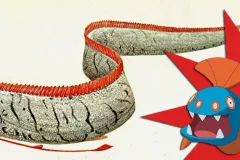Our Favorite Water Pokémon and Their Real-Life Doppelgängers

Pokémon Go came out in the United States last week and it’s safe to say that the gaming community is collectively losing its mind. Already boasting an estimated 7.5 million downloads as of Monday, 6 days after the release, the Nintendo-owned franchise is making a raging comeback. The game uses your smartphone’s GPS to locate virtual Pokémon in your vicinity allowing the player to both see and “capture” Pokémon à la augmented reality through your phone’s camera. Still confused? Check out this explainer.
Pokémon mania has rekindled some serious nostalgia at the Ocean Portal so we decided to feature our favorite water Pokémon (because let’s face it, Cerulean Gym would have obviously been our alma mater) and the ocean creatures they’re inspired by.

Background image: © John Norris Wood
Huntail // Oarfish
Like the Huntail, oarfish are deep-sea fish that rarely gravitate to surface waters. Oarfish can grow up to 36 feet (11 m) and weigh over 600 pounds (270 kg)! Human encounters with this bony fish are extremely rare; however, oarfish may be partly responsible for a handful of sea serpent legends since they float to the surface of the ocean when sick or dying.

Background image: National Oceanic and Atmospheric Adminstration
Magikarp // Yellow rockfish
Pokémon’s creators likely intended Magikarp to represent a real-life carp, but it looks more like a yelloweye rockfish to us. Yelloweye rockfish are among the longest-lived fish species, some reaching a ripe age of 147 years. This species of rockfish is currently recovering from unsustainable fishing pressures along the West Coast of the U.S., a process that will likely take many years due to their slow development—they don’t reach sexual maturity until age 20.
Background image: ROV Pilot, Wikimedia Commons
Gorebyss // Long-nosed chimaera
The Gorebyss looks positively cheery next to its real-life counterpart. The long-nosed chimaera is extremely elusive, living at abyssal depths of 3,000 feet (914 meters) and below. Distant cousins to sharks and rays, they have a venomous barb at the back of their head for defense.
Background image: © Alexander R. Jenner
Shellos // Chromodoris lochi
Both Shellos Chromodoris lochi are members of the sea slug family. Like a number of nudibranchs, they feed on sponges and only grow to be about four centimeters in length. The beautiful colors of nudibranchs often advertise the fact that they taste terrible, having acquired noxious chemicals from their prey. This is how they protect themselves, rather than with a shell like most other snails.

Background image: © Hopcroft/UAF/CoML
Manaphy/phione // Pteropod
Manaphy and Phione are seafaring and sea drifter Pokémon respectively. Their real-world double, the pteropod, is a specialized free-swimming gastropod related to sea snails and sea slugs. Colloquially called “sea butterflies,” the pteropod has become the poster child for ocean acidification after studies revealed that increasing water acidity is dissolving their outer shells at an alarming rate.
Background image: © Per-Ola Norman
Alomomola // Mola mola
These fish share more than just a similar name. Both are characterized by the lack of a proper tail fin. The Mola mola uses its large dorsal and anal fins to clumsily propel itself through the water column. Mola mola will often become so infested with skin parasites that they will bask at the surface of the ocean allowing small fish and even birds to pick their bodies clean.
Background image: © Eric Kilby
Skrelp // Weedy sea dragon
Skrelp and the weedy sea dragon were probably separated at birth. Like Skrelp (a Mock Kelp Pokémon), weedy sea dragons’ leaf-like appendages imitate swaying seaweed, allowing them to hide in plain sight. Endemic to the waters off south and east Australia, weedy sea dragons are threatened by pollution and the increasing loss of suitable seagrass beds for them to call home.
Background image: © Burton Bradstock
Omanyte // Ammonite
Although Omanyte is considered an extinct Pokémon, it can be revived from its fossil form. Unfortunately, the same can’t be said for its fossil twin, the ammonite, which has been extinct for about 66 million years. Closely related to octopuses, squid and cuttlefish but with a large external shell, these marine mollusks measured up to around 4.5 feet (137 cm).
Background image: © Robert Pittman
Kyogre // Orca
Kyogre, the battle-ready, bionic-looking Pokémon version of an orca, can both jet through high seas AND fly. Although our real world orca can’t fly, it can breach several feet into the air. Orca are fierce predators and hunt in packs, earning them the title “wolves of the sea.”






